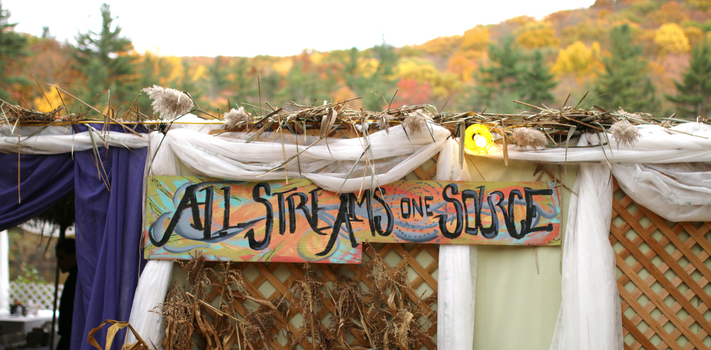What is Sukkot?
The Jewish holiday of Sukkot celebrates the Fall Harvest. We are told to sleep, eat, and relax outdoors in our sukkah. Sukkot also celebrates the time when farmers have completed their harvest and are able to indulge in some relaxation before the first rains of the season hit. This holiday inherently relates to the environment, where we are gathering our seasonal fall produce from. Sukkot celebrates our seasonal food gatherings and the environment, hence during this holiday we should be more mindful of the impact that our celebrations have on the world around us.
Activities & Rituals
“Branch” Out. Invite your favorite farmer into your sukkah for a meal and ask him/her how the harvest went. Don’t know a farmer? Go to a local farmers market for some produce and congratulate one of the farmers there on a job well done. Even better, find out where a local farm is and go straight to the source for some seasonal goodies.
Meditate. Take the time to recite blessings before and after every meal during Sukkot and think about all of the hard work and resources that went in to bringing the food to your table. Consider reading Thanks a Thousand by A. J. Jacobs, which chronicles an incredible journey to thank every person involved in making a cup of coffee – most of whom we never think about.
Green Sukkah Contest. Team up with other members of your congregation to have a “who can build the greenest sukkah?” competition. How many recycled, creative items, can you and your team incorporate into your sukkah decorations? You and your congregation choose what reward would be most suitable for you to offer the contest winners! You can get ideas from the Sukkah City Contest based in Union Square, New York City which was held in 2010.
Food & Recipes
Sukkot Recipes
Pumpkin Souffle Recipe
Preheat oven to 400
- 6 baby pumpkins-tops cut off and reserved, hollowed out to create a cavity
- 3 T. canola oil
- ½ cup raw sugar for the custard
- 2 T. canola oil
- 2 T. AP flour
- 2 cups apple cider-heated
- ½ cup brown sugar
- 4 eggs at room temperature-separated
- 1 vanilla bean scraped
- ¾ cup pumpkin puree
- 3 t. ground cinnamon
- ½ t. grated nutmeg
- ¼ cup granulated sugar
Place a small sauce pan over medium heat. Add the oil. When it gets hot add the flour and whisk it together. Add the apple cider and whisk together until mixture is very thick. Add a small amount of the apple cider mixture to the egg yolks and constantly whisk the yolks. This helps temper the egg yolks and keeps them from “scrambling”. Add the remaining ingredients except the egg whites and ¼ cup of granulated sugar. Stir over low heat until the mixture is very thick. Cool completely.
Whip the whites at medium high speed until soft peaks begin to form. Increase the speed to high and slowly add the sugar until stiff peaks form.
Fold the whites in 3 additions to the pumpkin custard mixture.
Brush the insides of the pumpkins with the canola oil. Coat the insides of the pumpkins with the sugar (this helps the soufflé climb up the sides and “hold on”). Gently spoon the soufflé mixture into the prepared pumpkins. Place the pumpkins on a baking sheet and bake until the soufflé rises out of the top and has formed a light brown crust. Sprinkle with powdered sugar and serve immediately.
I like to place a pumpkin on each plate with the lid leaning against it.
Recipe originally taken from The Jew and the Carrot
Vegetable Tangine with Cous Cous Recipe
- 2 tablespoons oil
- 2 small onions, roughly chopped
- 2 teaspoons ground cumin
- 2 teaspoons ground coriander
- 1 teaspoon crushed red pepper or chili powder
- 1 teaspoon cinnamon
- 2 cloves garlic, minced
- 1 tablespoon tomato paste
- 1 medium butternut squash, peeled and cut into chunks
- 1 sweet potato, cut into chunks
- 2 carrots, cut into chunks
- ½ cup chopped dried apricots
- 4 cups vegetable stock or broth, divided
- 2 tablespoons lemon juice
- Salt and pepper
- 1 20-ounce can chickpeas, drained and rinsed
- 2 tablespoons chopped parsley, plus more for garnish
- ¼ cup chopped fresh cilantro, plus more for garnish
- 3 cups couscous
- 2 cups boiling water
- 1½ cups hot vegetable broth
- Pomegranate seeds (optional)
Heat the oil in a large skillet with lid over medium heat. Add the onions and cook until soft, about 10 minutes.
Add the cumin, coriander, crushed red pepper, cinnamon, garlic, and tomato paste; cook for a minute or two until fragrant.
Add the squash, sweet potato, carrots, and dried apricots and toss well to coat. Pour 2½ cups of the stock and the lemon juice over the vegetables and bring to a gentle simmer.
Cook partially covered over a low heat for about 30 minutes until the vegetables are tender. Season with salt and pepper. Add the chickpeas, parsley, and cilantro and simmer for an additional 5 to 10 minutes.
Meanwhile, put the couscous in a large baking dish and spread it into a thin, even layer. Pour over the boiling water and remaining 1½ cups broth and cover with a lid or tin foil. bring Let stand for 10 to 15 minutes, until all the liquid has been absorbed into the couscous. Fluff gently with a fork.
To serve, put the couscous on a large serving platter. Spoon the vegetable tagine on top. Garnish with additional chopped parsley and cilantro, plus pomegranate seeds if you like.
Recipe originally from The Jew and the Carrot
Pear, Date, Pomegranate, and Goat Cheese Salad with Pomegranate Vinaigrette
For the Salad:
- 9 ounces mixed greens
- 1 pear, sliced
- ½ cup pitted and sliced Medjool dates
- ¼ cups pomegranate seeds
- ½ cups coarsely chopped walnuts
- ½ cups dried cranberries
- 3 ounces goat cheese, crumbled
For the Vinaigrette:
- ½ cup pomegranate juice
- 2 tablespoons red wine vinegar
- 1-2 teaspoons Dijon mustard
- 1 tablespoon date honey (sub regular honey)
- ½ cup extra virgin olive oil
Make the Salad: Put all the ingredients in a salad bowl. Toss with pomegranate vinaigrette (recipe below) or serve on the side.
For the Vinaigrette: Combine all the ingredients in a food processor, or vigorously whisk together by hand. Taste and adjust as necessary.
Note: To make pareve simple omit the goat cheese.
Recipe originally from The Jew and the Carrot
Stuffed Tomatoes with Zucchini, Mushrooms, Parmesan, and Pine Nuts
- ½ cup breadcrumbs
- ¼ cups pine nuts
- 6 large, ripe tomatoes
- Olive oil
- 1 zucchini, chopped (about 1½ cups)
- 1½ cups chopped mushrooms
- 4 cloves garlic, minced
- ¼ cup grated Parmesan
- 2 tablespoons chopped parsley
- Salt
- Freshly ground pepper
- 4 ounces fresh mozzarella
Pre-heat the oven to 350F.
Prepare the tomatoes: Slice the top off each tomato and, using a knife and spoon carefully scoop out the seeds from the inside so the tomatoes form little cups. Lightly grease a baking dish with olive oil. Put the tomatoes in the dish so the open end is up. Set aside.
Heat a little olive oil in a large skillet over medium heat. Add the zucchini, mushrooms, onion, and garlic and sauté until softened, 5 to 10 minutes. Remove from the heat and transfer to a large bowl to cool slightly.
Meanwhile, heat a small nonstick pan over medium heat. Add the breadcrumbs and pine nuts and toast until golden brown, about 5 minutes (be careful not to burn them).
Gently stir in the Parmesan, toasted breadcrumbs and pine nuts, and parsley to the zucchini and mushroom mixture. Season with salt and freshly ground pepper. Spoon the filling into each tomato.
Bake 15 minutes, then remove from the oven and top evenly with the mozzarella. Return to the oven and bake, uncovered, another 10 minutes, or until the tomatoes are tender but not blistering and the cheese has melted.
Note: To make pareve/vegan omit the Parmesan and mozzarella. It will still be very tasty.
Recipe originally from The Jew and the Carrot
Apple-Plum-Pear Crisp with Prunes and Walnuts
- 2 pears, cored and cut into bite-size pieces
- 2 green apples, cored and cut into bite-size pieces
- 4 small black plums, cored and cut into bite-size pieces
- ½ cup prunes (from about 6 prunes)
- ¼ cup golden raisins
- ¼ cup sugar
- 2 tablespoons lemon juice
- 1 teaspoon grated lemon zest
- ¼ cup corn starch
- 1½ cups all-purpose flour
- 1 cup old-fashioned oatmeal
- ½ cup granulated sugar
- ½ cup dark brown sugar
- 1 teaspoon cinnamon
- ½ teaspoon salt
- ½ cup coarsely chopped walnuts
- 5 tablespoons butter
Preheat the oven to 350F.
Toss together the pears, apples, plums, prunes, raisins, sugar, lemon juice, lemon zest, and corn starch in a large bowl. Transfer to an 11- by 9-inch baking pan and set aside.
Make the topping: mix together the flour, oatmeal, granulated sugar, brown sugar, cinnamon, salt, and walnuts. Stir in the butter until it is fully incorporated and so that coarse crumbs form (I find using my hands works best).
Spread the topping evenly over the filling.
Transfer to the oven and bake, uncovered, 45 minutes to 1 hour, until top is golden brown and filling starts to bubble up. Remove from the oven and allow to rest before serving.
Recipe originally from The Jew and the Carrot
Sustainability Tips
Celebrate the Harvest Season by Eating Local. Think about the food you normally eat during one week and calculate how far that food travels to get to your plate. During the week of Sukkot, try to cut those miles in half. Want to take it a step further? Commit to eating only foods produced within 250 miles for the entire week of Sukkot.
Drink Organic Wine
Sukkot should be a time of rejoicing. Say “L’Chaim” over organic wine and/or other locally distilled or brewed beverages.
Go Vegetarian! Celebrate the bounty of the harvest by eating a vegetarian diet during the week of Sukkot.
Host a Sustainable Sukkot Meal
It is a mitzvah to eat in the sukkah on the first night of Sukkot. Host a sustainable Sukkot meal and invite your guests to bring dishes that include local, sustainable ingredients.
Bake Sustainable Challah!
Bake your own sustainable challah! Tips: Use organic flour that was harvested within 200 miles; local, organic eggs; and local honey instead of sugar.
Reuse and Recycle
Commit to using only reusable or recyclable plates and cutlery in your Sukkah. In addition, recycle your lulav and etrog! Here are some creative ideas on ways to reuse your lulav and etrog.
Decorate Sustainably
Raid the recycling bin with kids to create one-of-a-kind recycled Sukkot decorations.
Host a Green Kiddush in the Sukkah
Serve local apples and honey; salads made of seasonal produce; and egg salad made out of local, organic eggs. Our Green Kiddush Guide makes thinking about a green kiddush easy!
Compost!
Use Sukkot as an opportunity to start composting. Look for places to compost your skach, lulav, and etrog after the holiday. Start your parsley plants on Tu B’Shvat with the soil you produce from your Sukkot scraps!
Dig In
Hazon Resources
Food for Thought – A 130-page sourcebook that draws on a range of texts from within and beyond Jewish traditions to explore a range of topics relating to Jews and food.
My Jewish Learning – Sukkot 101
Additional articles Relating to Sukkot




